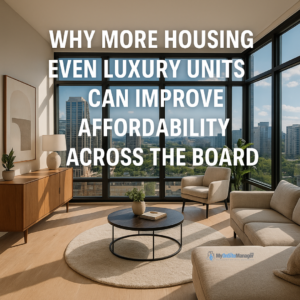Whenever the conversation turns to housing affordability, most people’s minds immediately jump to one solution: build more affordable housing. It’s an understandable reaction after all, rents have been rising sharply, and lower-income families are feeling the squeeze the most.
But according to economist Bill Conerly, author of a recent Forbes article, the reality is more nuanced. One of the most effective ways to improve affordability isn’t just about what kind of housing we build, but how much we build period. His message is clear and data-backed: building anything helps everything.
In simple terms, more housing of any type increases supply, which reduces overall market pressure. Whether the construction is luxury, mid-range, or affordable, every new development plays a role in balancing the market and that’s good news for renters at all levels.
How “Filtering” Keeps the Market Flowing
Conerly introduces the concept of “filtering” an economic process where new, higher-end housing indirectly creates more opportunities in lower-priced segments.
Here’s how it works:
-
A developer builds a new luxury apartment complex.
-
Wealthier renters move into those units, leaving behind their older, mid-tier apartments.
-
Those mid-tier units now become available and are often rented out at slightly lower rates to moderate-income households.
-
As those renters move up, more lower-cost units open up for others.
This creates a ripple effect across the market. Even if the new buildings aren’t “affordable housing” in name, they increase mobility and ease price pressures in other segments.
In Conerly’s words, “Economics clearly shows that more high-end apartment construction leads to lower prices at the low end of the market.”
Why Restricting Luxury Housing Can Backfire
It’s a common belief that building luxury housing drives up prices for everyone else. But data tells a different story.
When new development is restricted often due to zoning regulations, community resistance, or long permitting processes the overall housing supply tightens. As a result, every price tier gets squeezed.
Conerly emphasizes that even luxury buildings, once completed, help prevent “bidding wars” for limited units. Over time, these high-end projects filter down to middle-income and lower-income tenants. Meanwhile, if we stop or slow these developments, demand doesn’t disappear it just drives rents higher for existing properties.
In short: Stopping luxury housing doesn’t protect affordable housing; it makes housing scarcer for everyone.
A Realistic Look at Market Dynamics
Of course, filtering doesn’t happen overnight. Housing markets are complex ecosystems influenced by:
-
Construction costs and interest rates
-
Local zoning restrictions
-
Labor shortages and material delays
-
Population growth and urban migration
But the long-term pattern remains consistent: building more housing, in any form, helps reduce overall costs. When cities encourage new construction, they not only attract investment but also create room for existing residents to find homes that better fit their needs and budgets.
This isn’t just theory it’s what economists observe in real housing markets from San Francisco to Austin to Los Angeles. Cities that allow more construction see slower rent increases than those that heavily restrict it.
Policy and Planning Implications
Conerly’s insights carry significant weight for policymakers, developers, and property managers alike. To truly address affordability, housing policy should focus on abundance not just affordability mandates.
Some actionable implications include:
-
Streamlining the permitting process: Cities should reduce red tape and accelerate approvals for new housing.
-
Revisiting zoning laws: Outdated single-family zoning limits density and drives up land costs.
-
Encouraging mixed-use developments: Combining retail and residential spaces promotes vibrant communities and expands housing stock.
-
Partnering with private developers: Incentives for private builders can speed up production across multiple price tiers.
For property managers and investors, understanding these dynamics helps guide long-term strategy especially when planning acquisitions, renovations, or pricing models.
The Property Manager’s Perspective
For those in property management, including teams like MyOnsiteManager, this article offers a fresh lens on market behavior.
More construction can mean:
-
Higher tenant mobility: Renters have more options, leading to smoother transitions and faster lease-ups.
-
Increased maintenance and turnover needs: As people move more frequently, managers should refine processes for unit inspections, repairs, and cleaning.
-
Shifting rent expectations: Market rates may stabilize, so owners and managers should balance competitiveness with value-driven amenities.
-
More diverse portfolios: Managing both luxury and affordable properties can position firms to serve a broader tenant base.
Ultimately, building more units creates a healthier, more flexible housing ecosystem one that benefits renters, owners, and communities alike.
Balancing Growth and Community Concerns
Of course, not every community embraces new construction. Local opposition often called “NIMBYism” (“Not In My Backyard”) can slow progress, especially in established neighborhoods.
However, smart growth doesn’t mean unchecked development. Instead, it means encouraging responsible, well-planned projects that respect local character while meeting growing demand.
Transparent communication, community involvement, and sustainable design are key. When residents understand that new housing benefits everyone, resistance often turns into collaboration.
Looking Ahead: Building for the Future
The takeaway is simple but profound: housing markets work best when they’re allowed to grow.
When supply expands, affordability improves. When construction slows, scarcity worsens.
Whether you’re managing a small apartment complex or overseeing large portfolios, it’s vital to see your role in this broader housing story. Every new building whether luxury, workforce, or affordable adds capacity and flexibility to the system.
By supporting policies that make it easier to build, property managers, owners, and developers all become part of the long-term solution to housing challenges.
Final Thoughts
The debate over “luxury vs affordable housing” misses the bigger picture. The real question isn’t what kind of housing we build it’s whether we build enough.
When we build more, everyone benefits. The market stabilizes, tenants gain mobility, and communities become more resilient. It’s not just an economic principle it’s a social one.
At the end of the day, building anything truly helps everything.

